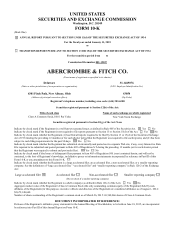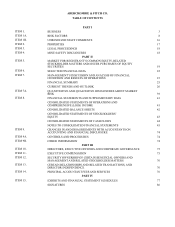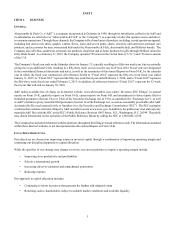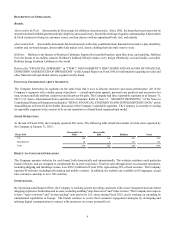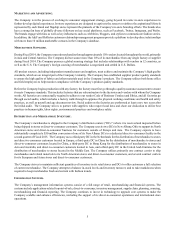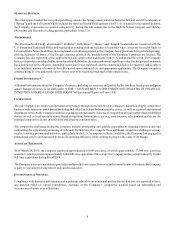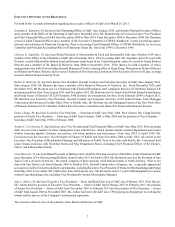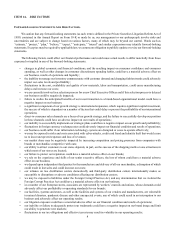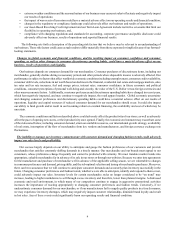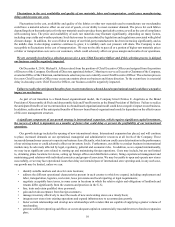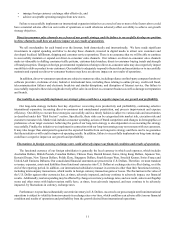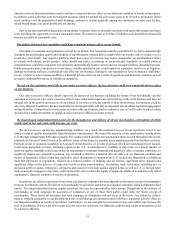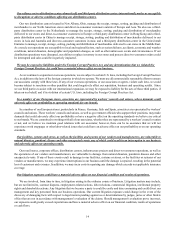Abercrombie & Fitch 2014 Annual Report Download - page 5
Download and view the complete annual report
Please find page 5 of the 2014 Abercrombie & Fitch annual report below. You can navigate through the pages in the report by either clicking on the pages listed below, or by using the keyword search tool below to find specific information within the annual report.5
MARKETING AND ADVERTISING.
The Company is in the process of evolving its consumer engagement strategy, going beyond its iconic in-store experiences to
further develop digital experiences. In-store experiences are designed to captivate the senses to reinforce the aspirational lifestyle
represented by each brand and flagship stores represent the pinnacle of the Company's in-store branding efforts. The brands also
have a strong fan base of globally diverse followers on key social platforms, such as Facebook, Twitter, Instagram, and Weibo.
The brands engage with fans as well as key influencers such as celebrities, bloggers, and stylists to communicate fashion stories.
In addition, the A&F and Hollister customer relationship management programs provide a platform to develop direct relationships
with more than 10 million marketable contacts in the Company's database.
MERCHANDISE SUPPLIERS.
During Fiscal 2014, the Company sourced merchandise through approximately 150 vendors located throughout the world, primarily
in Asia and Central America. The Company did not source more than 10% of its merchandise from any single factory or supplier
during Fiscal 2014. The Company pursues a global sourcing strategy that includes relationships with vendors in 12 countries, as
well as the U.S. The Company’s foreign sourcing of merchandise is negotiated and settled in U.S. Dollars.
All product sources, including independent manufacturers and suppliers, must achieve and maintain the Company’s high quality
standards, which are an integral part of the Company’s identity. The Company has established supplier product quality standards
to ensure the high quality of fabrics and other materials used in the Company’s products. The Company utilizes both home office
and field employees to help monitor compliance with the Company’s product quality standards.
Before the Company begins production with any factory, the factory must first go through a quality assurance assessment to ensure
it meets Company standards. This includes factories that are subcontractors to the factories and vendors with whom the Company
works. All factories are contractually required to adhere to our vendor Code of Business Conduct and Ethics, and all factories go
through social audits, which includes a factory walk-through to appraise the physical working conditions and health and safety
practices, as well as payroll and age document review. Social audits on the factories are performed at least every two years after
the initial audit. The Company strives to partner with suppliers who respect local laws and share our dedication to utilize best
practices in human rights, labor rights, environmental practices and workplace safety.
DISTRIBUTION AND MERCHANDISE INVENTORY.
The Company’s merchandise is shipped to the Company’s distribution centers (“DCs”) where it is received and inspected before
being shipped to stores or direct-to-consumer customers. The Company uses its two DCs in New Albany, Ohio to support its North
American stores and direct-to-consumer business for customers outside of Europe and Asia. The Company expects to have
substantially completed a $50 million conversion of one of its New Albany DCs to a dedicated direct-to-consumer facility in the
second quarter of Fiscal 2015. The Company uses a third-party DC in the Netherlands for the distribution of merchandise to stores
and direct-to-consumer customers located in Europe, a third-party DC in China for the distribution of merchandise to stores and
direct-to-consumer customers located in China, a third-party DC in Hong Kong for the distribution of merchandise to stores in
Asia and Australia, and direct-to-consumer customers located in Asia, and a third-party DC in the United Arab Emirates for the
distribution of merchandise to stores located in the Middle East. The Company utilizes primarily one contract carrier to ship
merchandise and related materials to its North American stores and direct-to-consumer customers, and several contract carriers
for its European and Asian stores and direct-to-consumer customers.
The Company strives to maintain sufficient quantities of inventory in its retail stores and DCs to offer customers a full selection
of current merchandise. The Company attempts to balance in-stock levels and inventory turnover, and to take markdowns when
required to keep merchandise fresh and current with fashion trends.
INFORMATION SYSTEMS.
The Company’s management information systems consist of a full range of retail, merchandising and financial systems. The
systems include applications related to point-of-sale, direct-to-consumer, inventory management, supply chain, planning, sourcing,
merchandising and financial reporting. The Company continues to invest in technology to upgrade core systems to make the
Company scalable and enhance efficiencies, including the support of its direct-to-consumer operations and international store
operations.

